Participatory Scenario Development for Sustainable Cities: Literature Review and Case Study of Madrid, Spain
Abstract
1. Introduction
1.1. General Introduction
1.2. Research Background: Urban Mobility Transformations in Europe and Beyond
1.3. Madrid and the Sustainability Challenge
1.4. Scenarios in the Social and Environmental Sciences
1.5. Participatory Scenario Development Approaches for Urban Sustainability
1.6. Aims and Research Questions
2. Methods
2.1. Semi-Structured Interviews
2.2. Stakeholder Mapping and Sociogram
2.3. Analysis of Interview Results and Scenario Development
3. Results
3.1. Structure of Power and Affinity in the Stakeholder Community
3.2. Keyword Frequency in Participants’ Discourse
3.3. Main Themes Emergent from Interviewees’ Discourse
3.3.1. Public Transport Use Should Be Promoted
3.3.2. The City Is Designed Around the Car
3.3.3. The Influence of Urban Design on Sustainability
3.3.4. The Role of Electric Vehicles
3.3.5. The Car as a Cause of Air Pollution
3.3.6. The Need to Improve Bicycle Mobility
3.3.7. Walkability
3.3.8. Remote Working as an Opportunity to Improve Mobility
3.3.9. The Madrid Low-Emissions Zone
3.3.10. Last Mile Delivery
3.4. Scenario Development
- Step 1: The common framing and criteria. This step was provided by the introduction to the project and explanation of the terms of discussion given to the interviewees.
- Step 2: The current situation in relation to the problem of sustainable transport. This was defined by four main challenges (Q1) identified from participants’ discourse: (1) high number of motor vehicle trips, from which other problems arise; (2) the lack of safe and inclusive cycle and pedestrian infrastructure limiting sustainable travel modes; (3) the serious problem of air pollution and emissions; (4) the decline of public transport and the invasion of public space by cars and car-oriented infrastructure.
- Step 3: Envisage a future sustainable situation. This step emerged from the solutions to these problems (Q2): (1) reduction of motor vehicle volumes entering the city; (2) redesign of the city to increase bicycle and pedestrian trips at the expense of motor vehicles; (3) electrification of bicycles, cars, public transport; (4) freeing up space for inclusive public uses, including the widespread promotion of public transport over the car.
- Step 4. Strategies for sustainability. These emerged from step 3, in the form of four scenarios covering the four main points of divergence arising from the challenges and their solutions, as follows (Table 2).
| Natural Step 1 (Common Framework and Criteria) | Natural Step 2 (Challenges) | Natural Step 3 (Solutions) | Natural Step 4 (Scenarios) |
|---|---|---|---|
| Within the municipality of Madrid, it has been estimated that 74.4% of all local NO2 emissions, are attributable to road traffic. The scale and severity of this problem, together with the high economic and social cost of pollution caused by this mobility model, highlights the need to actively seek a more sustainable future for the city. | Challenge 1: | Solution 1: | S1: Remote Working |
| High number of motor vehicle trips, from which other problems arise. | Reduction of motor vehicle volumes entering the city. | An economic and social model which facilitates the transition from a system of work centered around the office to one where work is carried out completely or partially from the worker’s home or other nearby place (co-working space, café or library). This scenario aims to reduce work related journeys in private vehicles, in order to reduce traffic congestion, air pollution and greenhouse gas emissions. | |
| Challenge 2: | Solution 2: | S2: The 15-min City | |
| The lack of safe and inclusive cycle and pedestrian infrastructure limiting sustainable travel modes; | Redesign of the city to increase bicycle and pedestrian trips at the expense of motor vehicles; | A vision of the city where citizens can satisfy all their needs within a journey time of 15 min away from their home. This is ensured through zoning and policy changes. Although this may imply structural changes in the city, it aims to increase the accessibility of the city for everyone, as well as reducing air pollution and greenhouse gas emissions, and quality of life. | |
| Challenge 3: | Solution 3: | S3: Electric City | |
| The serious problem of air pollution and emissions resulting from circulation of polluting vehicles. | Electrification of bicycles, cars, public transport. | This scenario emphasizes technological development as a solution to air pollution and greenhouse gas emissions. It supposes the complete replacement of the current fossil-fueled vehicle fleet (petrol, LPG, diesel) with electric vehicles, for both public and private transport (buses, trains, trams etc.). It will be complemented by other kinds of electric transport, like bicycles and scooters. This scenario does not aim to change existing mobility patterns, so it would not reduce congestion or provide more space for non-motorized transport or pedestrians. However, it would eliminate most vehicle emissions from the city. | |
| Challenge 4: | Solution 4: | S4: The public city | |
| The decline of public transport and the invasion of public space by cars and car-oriented infrastructure. | Free-up space for inclusive public uses, including the widespread promotion of public transport over the car. | In contrast to problem-solving approaches usually taken by governments, this scenario seeks to build the capacity of individuals and groups (neighborhood associations, cooperative societies and other citizens’ collectives) to solve air pollution and greenhouse gas emissions. In this way, the scenario advances social justice and public health as key components for a transition to a pattern of mobility that is inclusive for all. This scenario promotes means of transport that are easily available and accessible without excluding less-wealthy neighborhoods. |
4. Discussion
4.1. Critical Discussion of Strengths, Weaknesses, Opportunities and Threats from Each Scenario
4.1.1. Remote Working
4.1.2. The 15-Minute City
4.1.3. Electric City
4.1.4. Public City
4.2. Applicability and International Transferability of Results
4.3. Limitations of the Study
4.4. Policy Recommendations
4.4.1. Social Justice/Equity
4.4.2. Difficulty of Structural Change, in Particular, Multi-Use Zoning
4.4.3. Political Polarization
4.4.4. Implementation
5. Conclusions
Author Contributions
Funding
Institutional Review Board Statement
Informed Consent Statement
Data Availability Statement
Acknowledgments
Conflicts of Interest
Appendix A
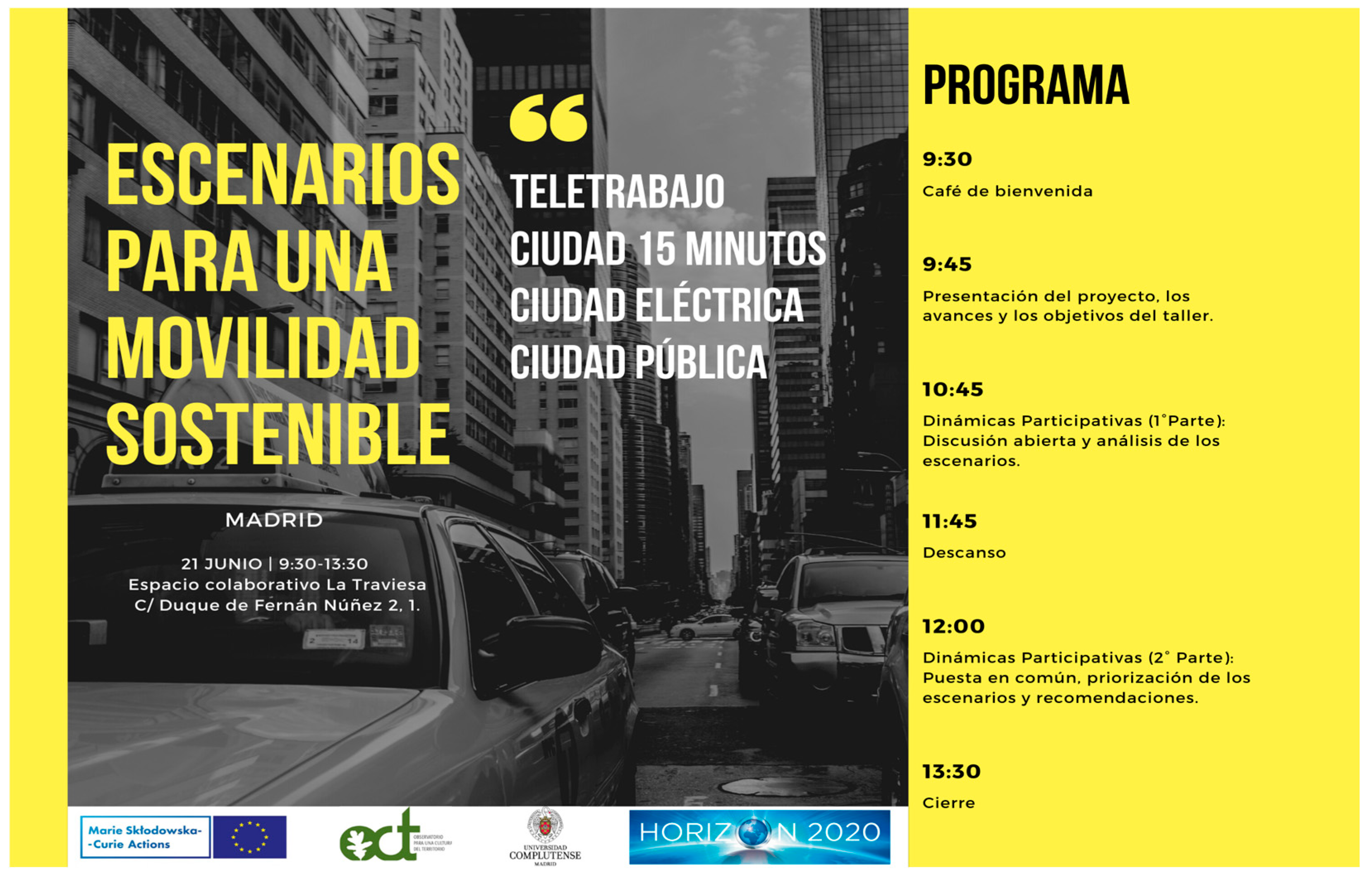
References
- EEA. Sources and Emissions of Air Pollutants in Europe. Web Report. 2022. Available online: https://www.eea.europa.eu/publications/air-quality-in-europe-2022/sources-and-emissions-of-air (accessed on 8 July 2022).
- Ravelli, Q. Fuel Feud. The Political Economy of the Yellow Vest. In The Political Economy of Social Movements; HAL (Le Centre pour la Communication Scientifique Directe): Paris, France, 2021; hal-03101145. [Google Scholar]
- Lebrusán, I.; Toutouh, J. Son Efectivas Las Zonas de Bajas Emisiones? El Caso Del Centro de Madrid. Papeles de Economía Española 2022, 171, 159–176. [Google Scholar]
- Baumann, C.; White, S. Making better choices: A systematic comparison of adversarial and collaborative approaches to the transport policy process. Transp. Policy 2012, 24, 83–90. [Google Scholar] [CrossRef]
- Bishop, P.; Hines, A.; Collins, T. The current state of scenario development: An overview of techniques. Foresight 2007, 9, 5–25. [Google Scholar] [CrossRef]
- Alcamo, J. (Ed.) Environmental Futures: The Practice of Environmental Scenario Analysis; Elsevier: Amsterdam, The Netherlands, 2008. [Google Scholar]
- Amer, M.; Daim, T.U.; Jetter, A. A review of scenario planning. Futures 2013, 46, 23–40. [Google Scholar] [CrossRef]
- Palomo, I.; Martín-López, B.; López-Santiago, C.; Montes, C. Participatory scenario planning for protected areas management under the ecosystem services framework: The Doñana social-ecological system in southwestern Spain. Ecol. Soc. 2011, 16, 23. [Google Scholar] [CrossRef]
- Duckett, D.G.; McKee, A.J.; Sutherland, L.A.; Kyle, C.; Boden, L.A.; Auty, H.; Bessell, P.R.; McKendrick, I.J. Scenario planning as communicative action: Lessons from participatory exercises conducted for the Scottish livestock industry. Technol. Forecast. Soc. Change 2017, 114, 138–151. [Google Scholar] [CrossRef]
- Ye, J.; Qin, Z.; Chen, X. Adapt by adopting cleaner vehicles?—Evidence from a low-emission zone policy in Nanchang, China. China Econ. Rev. 2021, 66, 101598. [Google Scholar] [CrossRef]
- Aulia, Y.; Nurcahyono, R.F.; Aprianto, R. Analisis Potensi NUEZPRO sebagai Model Kebijakan Ultra Low Emission Zone dalam Pembangunan Kota Berkelanjutan. Blend Sains J. Tek. 2025, 4, 74–81. [Google Scholar] [CrossRef]
- Oviedo, D.; Cavoli, C.; Levy, C.; Koroma, B.; Macarthy, J.; Sabogal, O.; Jones, P. Accessibility and sustainable mobility transitions in Africa: Insights from Freetown. J. Transp. Geogr. 2022, 105, 103464. [Google Scholar] [CrossRef]
- European Commission. Sustainable and Smart Mobility Strategy—Putting European Transport on Track for the Future. Communication COM(2020) 789 Final. 2020. Available online: https://eur-lex.europa.eu/legal-content/EN/TXT/?uri=CELEX%3A52020DC0789 (accessed on 11 August 2022).
- Tsavachidis, M.; Le Petit, Y. Re-shaping urban mobility–Key to Europe s green transition. J. Urban Mobil. 2022, 2, 100014. [Google Scholar] [CrossRef]
- CRTM (Madrid Region Transport Consortium). Mobility Survey Carried out in the Madrid Autonomous Region in 2018. 2019. Available online: https://www.crtm.es/media/emxacg4d/edm18_sintesis.pdf (accessed on 1 December 2022).
- Izquierdo, R.; Dos Santos, S.G.; Borge, R.; de La Paz, D.; Sarigiannis, D.; Gotti, A.; Boldo, E. Health impact assessment by the implementation of Madrid City air-quality plan in 2020. Environ. Res. 2020, 183, 109021. [Google Scholar] [CrossRef]
- Ayuntamiento de Madrid. Plan A: Plan de Calidad del Aire y Cambio Climático de Madrid. [Plan A: Air Quality and Climate Change Plan for Madrid]. 2019. Available online: https://transparencia.madrid.es/UnidadesDescentralizadas/Sostenibilidad/CalidadAire/Ficheros/PlanACalidadAire2019.pdf (accessed on 3 May 2022).
- Escobar, F.; Van Delden, H.; Hewitt, R. LUCC scenarios. In Geomatic Approaches for Modeling Land Change Scenarios; Springer International Publishing: Cham, Switzerland, 2017; pp. 81–97. [Google Scholar]
- Dean, M. Scenario Planning: A Literature Review. A Paper Prepared as Part of the MORE (Multi-Modal Optimisation of Roadspace in Europe) Project—Work Package 3 (Future Scenarios: New Technologies, Demographics and Patterns of Demand). Project Number: 769276-2; UCL Department of Civil, Environmental and Geomatic Engineering: London, UK, 2019. [Google Scholar]
- Guivarch, C.; Lempert, R.; Trutnevyte, E. Scenario techniques for energy and environmental research: An overview of recent developments to broaden the capacity to deal with complexity and uncertainty. Environ. Model. Softw. 2017, 97, 201–210. [Google Scholar] [CrossRef]
- Bradfield, R.; Wright, G.; Burt, G.; Cairns, G.; Van Der Heijden, K. The origins and evolution of scenario techniques in long range business planning. Futures 2005, 37, 795–812. [Google Scholar] [CrossRef]
- Bibri, S.E. Backcasting in futures studies: A synthesized scholarly and planning approach to strategic smart sustainable city development. Eur. J. Futures Res. 2018, 6, 13. [Google Scholar] [CrossRef]
- Durance, P.; Godet, M. Scenario building: Uses and abuses. Technol. Forecast. Soc. Change 2010, 77, 1488–1492. [Google Scholar] [CrossRef]
- Nazarenko, L.; Schmidt, G.A.; Miller, R.L.; Tausnev, N.; Kelley, M.; Ruedy, R.; Russell, G.L.; Aleinov, I.; Bauer, M.; Bauer, S.; et al. Future climate change under RCP emission scenarios with GISS Model E2. J. Adv. Model. Earth Syst. 2015, 7, 244–267. [Google Scholar] [CrossRef]
- O’Neill, B.C.; Kriegler, E.; Riahi, K.; Ebi, K.L.; Hallegatte, S.; Carter, T.R.; Mathur, R.; van Vuuren, D.P. A new scenario framework for climate change research: The concept of shared socioeconomic pathways. Clim. Change 2014, 122, 387–400. [Google Scholar] [CrossRef]
- Wang, R.; Xiong, J.; He, M.F.; Gao, L.; Wang, L. Multi-objective optimal design of hybrid renewable energy system under multiple scenarios. Renew. Energy 2020, 151, 226–237. [Google Scholar] [CrossRef]
- Arnstein, S.R. A ladder of citizen participation. J. Am. Inst. Plan. 1969, 35, 216–224. [Google Scholar] [CrossRef]
- Ley, D.F.; Anderson, G. The Delphi technique in urban forecasting. Reg. Stud. 1975, 9, 243–249. [Google Scholar] [CrossRef]
- Alterman, R. Planning for public participation: The design of implementable strategies. Environ. Plan. B Plan. Des. 1982, 9, 295–313. [Google Scholar] [CrossRef]
- Khakee, A. Futures-oriented municipal planning. Technol. Forecast. Soc. Change 1985, 28, 63–83. [Google Scholar] [CrossRef]
- Khakee, A. Scenario construction for urban planning. Omega 1991, 19, 459–469. Available online: https://www.diva-portal.org/smash/get/diva2:1326502/FULLTEXT01.pdf (accessed on 2 September 2025). [CrossRef]
- Street, P. Scenario workshops: A participatory approach to sustainable urban living? Futures 1997, 29, 139–158. [Google Scholar] [CrossRef]
- Tress, B.; Tress, G. Scenario visualisation for participatory landscape planning—A study from Denmark. Landsc. Urban Plan. 2003, 64, 161–178. [Google Scholar] [CrossRef]
- Kok, K.; Rothman, D.S.; Patel, M. Multi-scale narratives from an IA perspective: Part I. European and Mediterranean scenario development. Futures 2006, 38, 261–284. [Google Scholar] [CrossRef]
- Walz, A.; Lardelli, C.; Behrendt, H.; Grêt-Regamey, A.; Lundström, C.; Kytzia, S.; Bebi, P. Participatory scenario analysis for integrated regional modelling. Landsc. Urban Plan. 2007, 81, 114–131. [Google Scholar] [CrossRef]
- Volkery, A.; Ribeiro, T.; Henrichs, T.; Hoogeveen, Y. Your vision or my model? Lessons from participatory land use scenario development on a European scale. Syst. Pract. Action Res. 2008, 21, 459–477. [Google Scholar] [CrossRef]
- Mayer, I.S.; van Bueren, E.M.; Bots, P.W.; van der Voort, H.; Seijdel, R. Collaborative decisionmaking for sustainable urban renewal projects: A simulation–gaming approach. Environ. Plan. B Plan. Des. 2005, 32, 403–423. [Google Scholar] [CrossRef]
- Loukopoulos, P.; Scholz, R.W. Sustainable future urban mobility: Using ‘area development negotiations’ for scenario assessment and participatory strategic planning. Environ. Plan. A 2004, 36, 2203–2226. [Google Scholar] [CrossRef]
- Drescher, M.; Skoyles, A. Urban climate change adaptation planning using participatory scenarios: A systematic review of methods and approaches. J. Environ. Plan. Manag. 2024, 1–24. [Google Scholar] [CrossRef]
- Abou Jaoude, G.; Mumm, O.; Carlow, V.M. An overview of scenario approaches: A guide for urban design and planning. J. Plan. Lit. 2022, 37, 467–487. [Google Scholar] [CrossRef]
- Geekiyanage, D.; Fernando, T.; Keraminiyage, K. Mapping participatory methods in the urban development process: A systematic review and case-based evidence analysis. Sustainability 2021, 13, 8992. [Google Scholar] [CrossRef]
- Soria-Lara, J.A.; Ariza-Álvarez, A.; Aguilera-Benavente, F.; Cascajo, R.; Arce-Ruiz, R.M.; López, C.; Gómez-Delgado, M. Participatory visioning for building disruptive future scenarios for transport and land use planning. J. Transp. Geogr. 2021, 90, 102907. [Google Scholar] [CrossRef]
- Hewitt, R.J.; Hernández-Jiménez, V.; Zazo-Moratalla, A.; Ocón-Martín, B.; Román-Bermejo, L.; Encinas-Escribano, M.A. Participatory Modelling for Resilient Futures: Action for Managing our Environment from the Bottom-Up; Elsevier: Amsterdam, The Netherlands, 2017; Volume 30. [Google Scholar]
- Stacchini, A.; Guizzardi, A.; Mariotti, A. Smoothing down arbitrariness in planning: From SWOT to participatory decision making. Land Use Policy 2022, 119, 106213. [Google Scholar] [CrossRef]
- Holmberg, J. Backcasting: A natural step in operationalising sustainable development. Greener Manag. Int. 1998, 23, 30–51. [Google Scholar]
- Phdungsilp, A. Futures studies’ backcasting method used for strategic sustainable city planning. Futures 2011, 43, 707–714. [Google Scholar] [CrossRef]
- Koskela, M. Expert views on environmental impacts and their measurement in the forest industry. J. Clean. Prod. 2011, 19, 1365–1376. [Google Scholar] [CrossRef]
- Van Renswouw, L.; Lallemand, C.; Van Wesemael, P.; Vos, S. Creating active urban environments: Insights from expert interviews. Cities Health 2023, 7, 463–479. [Google Scholar] [CrossRef]
- Puukko, S.; Heino, M.T.; Kostamo, K.; Saurio, K.; Sniehotta, F.F.; Hankonen, N. How do behavioral public policy experts see the role of complex systems perspectives? An expert interview study. Transl. Behav. Med. 2024, 14, 417–425. [Google Scholar] [CrossRef]
- Rodon, T.; Hierro, M.J. Podemos and Ciudadanos shake up the Spanish party system: The 2015 local and regional elections. South Eur. Soc. Politics 2016, 21, 339–357. [Google Scholar] [CrossRef]
- López de Lucio, R. Transformaciones territoriales recientes en la región urbana de Madrid. Urban 2003, 8, 124–161. [Google Scholar]
- Hernandez-Jimenez, V.; Winder, N. Chapter 12 Knowledge integration and power relations: Pathways to sustainability in Madrid. In Beyond the Rural-Urban Divide: Cross-Continental Perspectives on the Differentiated Countryside and Its Regulation; Emerald Group Publishing Limited: Leeds, UK, 2009; pp. 305–322. [Google Scholar]
- Hewitt, R.; Hernandez-Jimenez, V. Devolved regions, fragmented landscapes: The struggle for sustainability in Madrid. Sustainability 2010, 2, 1252–1281. [Google Scholar] [CrossRef]
- Naredo, J.M.; Frías, J. El Metabolismo Socioeconómico de la Comunidad de Madrid 1996-2010. Estadísticas Básicas del Metabolismo Socioeconómico; Fuhem-Ecosocial: Madrid, Spain, 2015. [Google Scholar]
- Orr, A.E.; Savage, T. Expanding access to and ensuring equity in the benefits of remote work following the COVID-19 pandemic. J. Sci. Policy Gov. 2021, 18, 1–8. [Google Scholar] [CrossRef]
- Moreno, C. The 15-Minute City: A Solution to Saving Our Time and Our Planet; John Wiley Sons: Hoboken, NJ, USA, 2024. [Google Scholar]
- Mazzucato, M. The Entrepreneurial State: Debunking Public vs. Private Sector Myths; Anthem Press: London, UK, 2015. [Google Scholar]
- Shang, W.L.; Zhang, J.; Wang, K.; Yang, H.; Ochieng, W. Can financial subsidy increase electric vehicle (EV) penetration—Evidence from a quasi-natural experiment. Renew. Sustain. Energy Rev. 2024, 190, 114021. [Google Scholar] [CrossRef]
- Sheldon, T.L.; Dua, R.; Alharbi, O.A. Electric vehicle subsidies: Time to accelerate or pump the brakes? Energy Econ. 2023, 120, 106641. [Google Scholar] [CrossRef]
- Allen, J.; Farber, S. Suburbanization of transport poverty. Ann. Am. Assoc. Geogr. 2021, 111, 1833–1850. [Google Scholar] [CrossRef]
- Cain, A.; Darido, G.; Baltes, M.R.; Rodriguez, P.; Barrios, J.C. Applicability of Bogota’s TransMilenio BRT System to the United States: Final Report, May 2006 (No. FL-26-7104-01); Federal Transit Administration. Office of Research, Demonstration, and Innovation: Washington, DC, USA, 2006.
- Bocarejo, J.P.; Portilla, I.J.; Velásquez, J.M.; Cruz, M.N.; Peña, A.; Oviedo, D.R. An innovative transit system and its impact on low income users: The case of the Metrocable in Medellín. J. Transp. Geogr. 2014, 39, 49–61. [Google Scholar] [CrossRef]
- Cerqueira, E.D.V.; Motte-Baumvol, B.; Chevallier, L.B.; Bonin, O. Does working from home reduce CO2 emissions? An analysis of travel patterns as dictated by workplaces. Transp. Res. Part D Transp. Environ. 2020, 83, 102338. [Google Scholar] [CrossRef]
- Stefaniec, A.; Brazil, W.; Whitney, W.; Zhang, W.; Colleary, B.; Caulfield, B. Examining the long-term reduction in commuting emissions from working from home. Transp. Res. Part D Transp. Environ. 2024, 127, 104063. [Google Scholar] [CrossRef]
- Rabbi, M.F.; Popp, J.; Máté, D.; Kovács, S. Energy security and energy transition to achieve carbon neutrality. Energies 2022, 15, 8126. [Google Scholar] [CrossRef]
- The Economist. Why China Is Winning the Trade War. Leader. Available online: https://www.economist.com/leaders/2025/10/23/why-china-is-winning-the-trade-war (accessed on 23 October 2025).
- Blenkinsop, D. EU Slaps Tariffs on Chinese EVs, Risking Beijing Backlash, Reuters. Available online: https://www.reuters.com/business/autos-transportation/eu-slaps-tariffs-chinese-evs-risking-beijing-payback-2024-10-29/ (accessed on 30 October 2024).
- Segales, M.; Hewitt, R.J.; Slee, B. Social innovation and global citizenship: Guiding principles for sustainable, just and democratic energy transition in cities. Energy Res. Soc. Sci. 2023, 106, 103295. [Google Scholar] [CrossRef]
- Wu, Y.; Martens, P.; Krafft, T. Public awareness, lifestyle and low-carbon city transformation in China: A systematic literature review. Sustainability 2022, 14, 10121. [Google Scholar] [CrossRef]
- Soloviy, I.; Melnykovych, M.; Gurung, A.B.; Hewitt, R.J.; Ustych, R.; Maksymiv, L.; Brang, P.; Meessen, H.; Kaflyk, M. Innovation in the use of wood energy in the Ukrainian Carpathians: Opportunities and threats for rural communities. For. Policy Econ. 2019, 104, 160–169. [Google Scholar] [CrossRef]
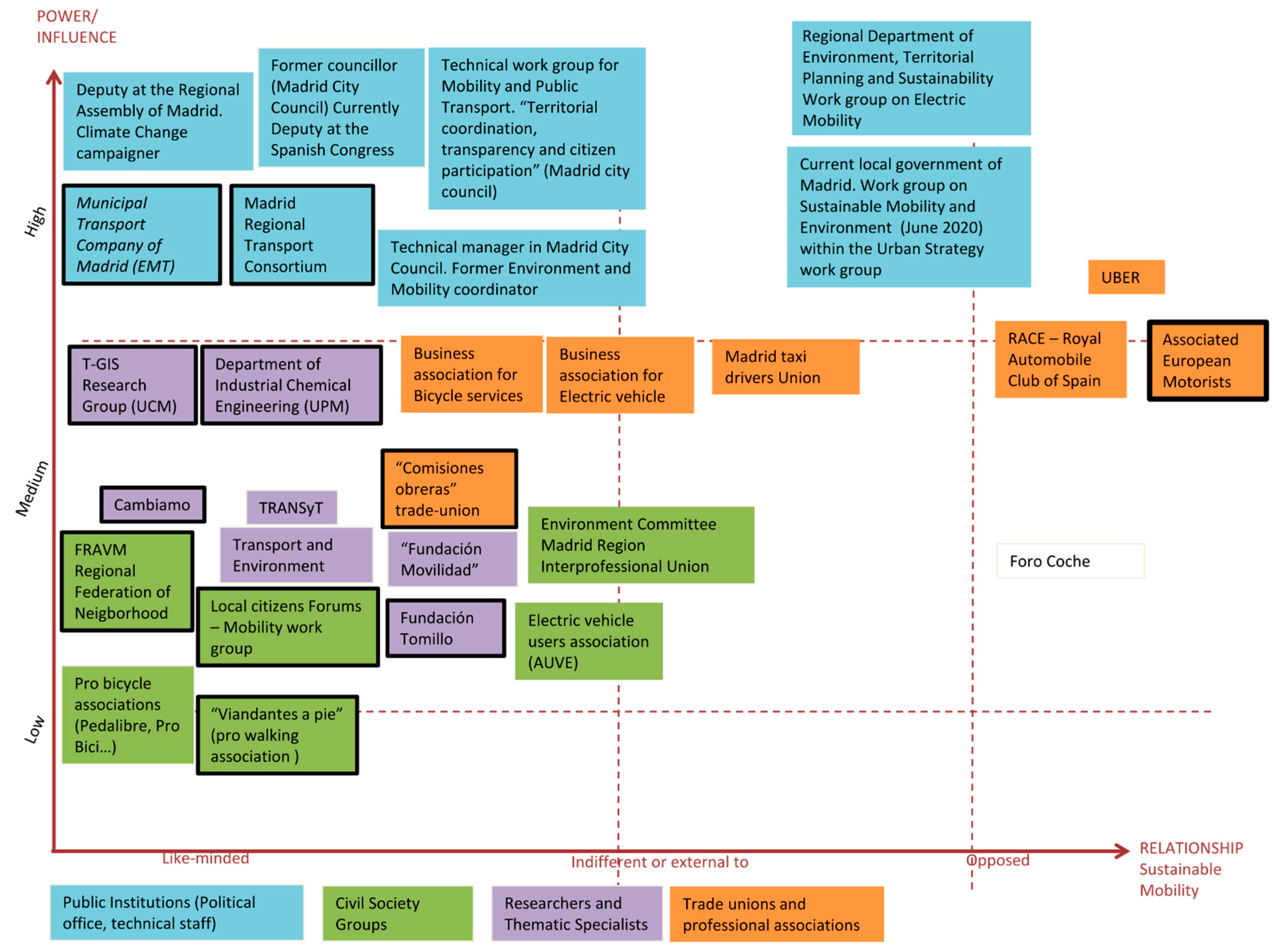

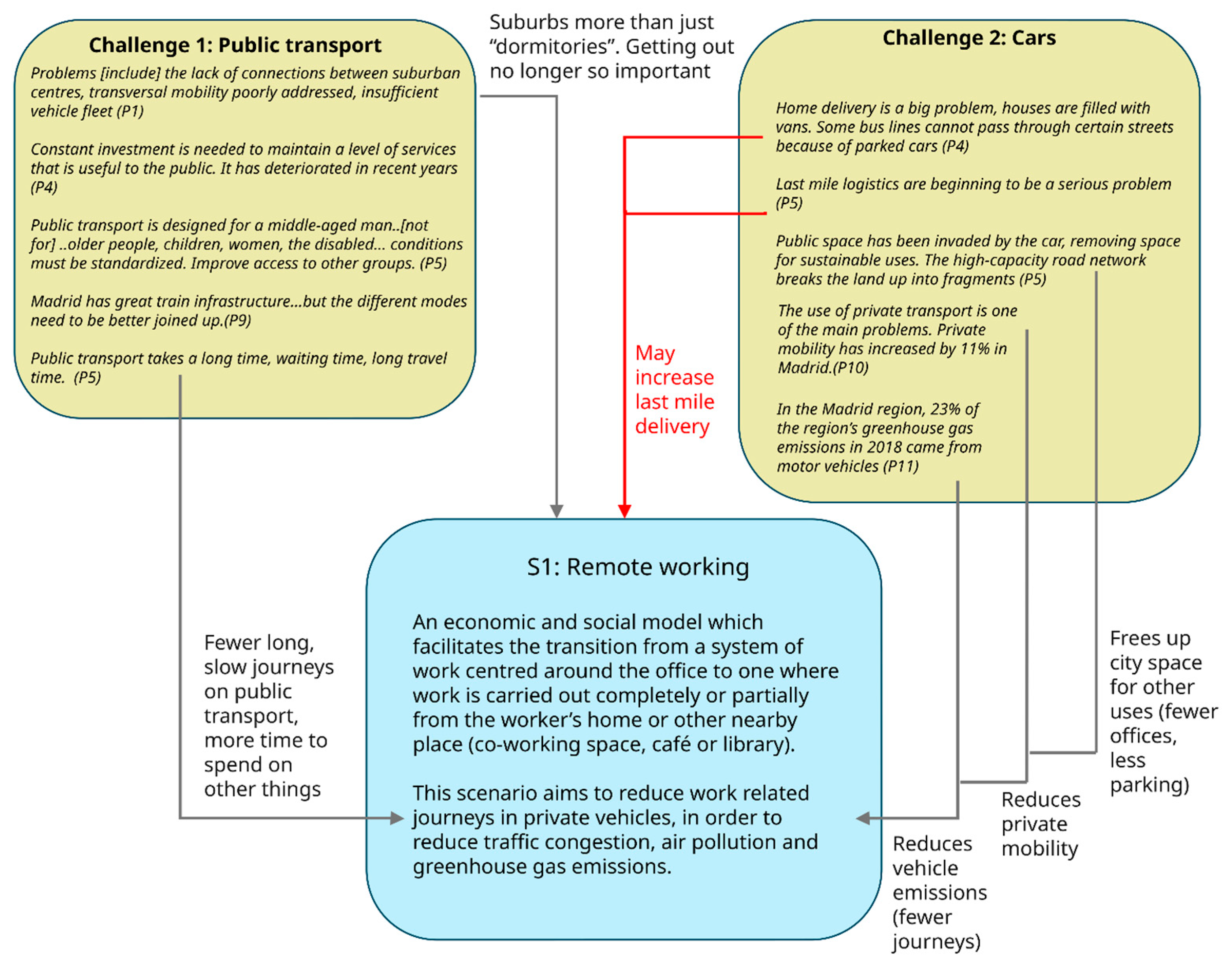

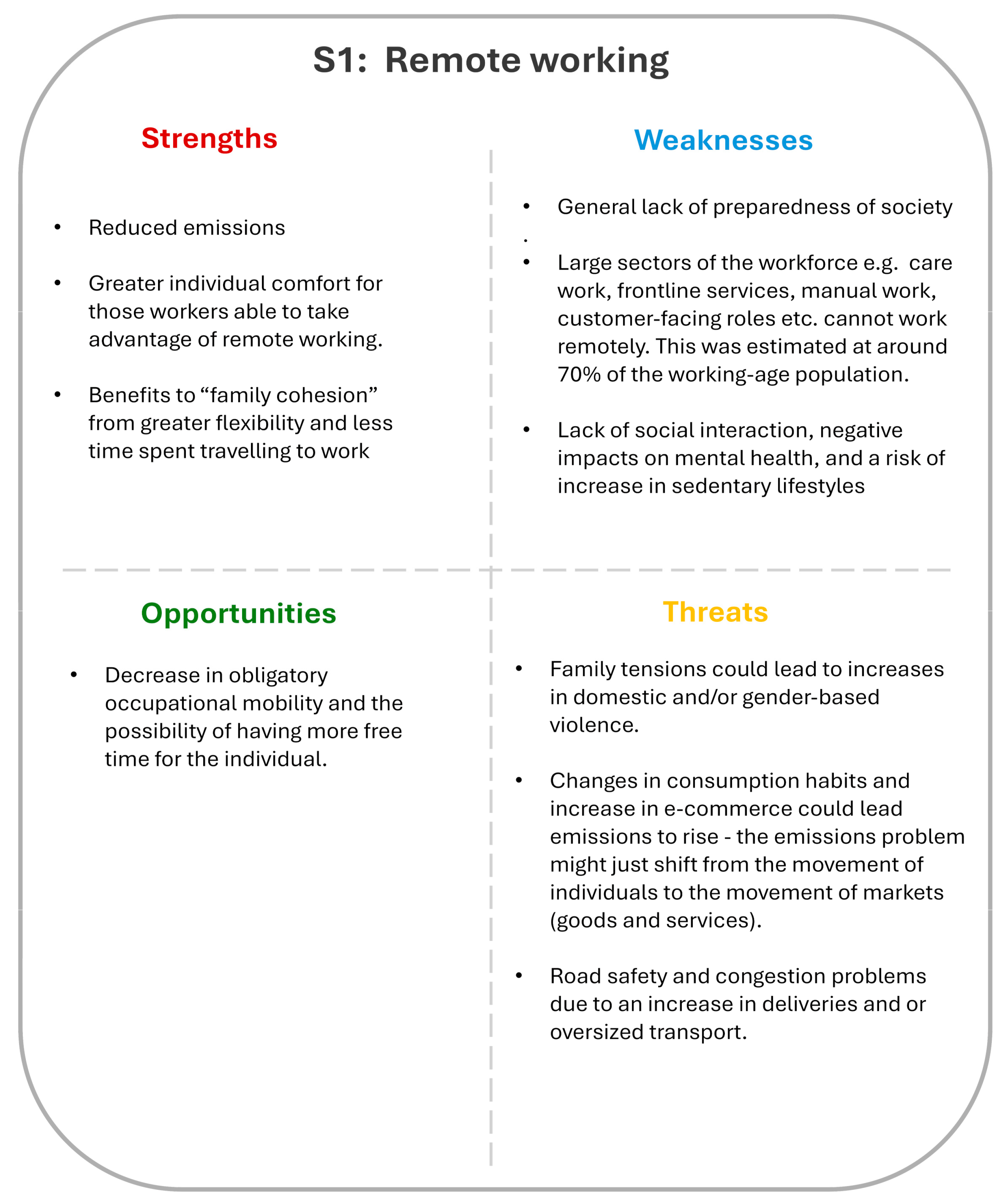
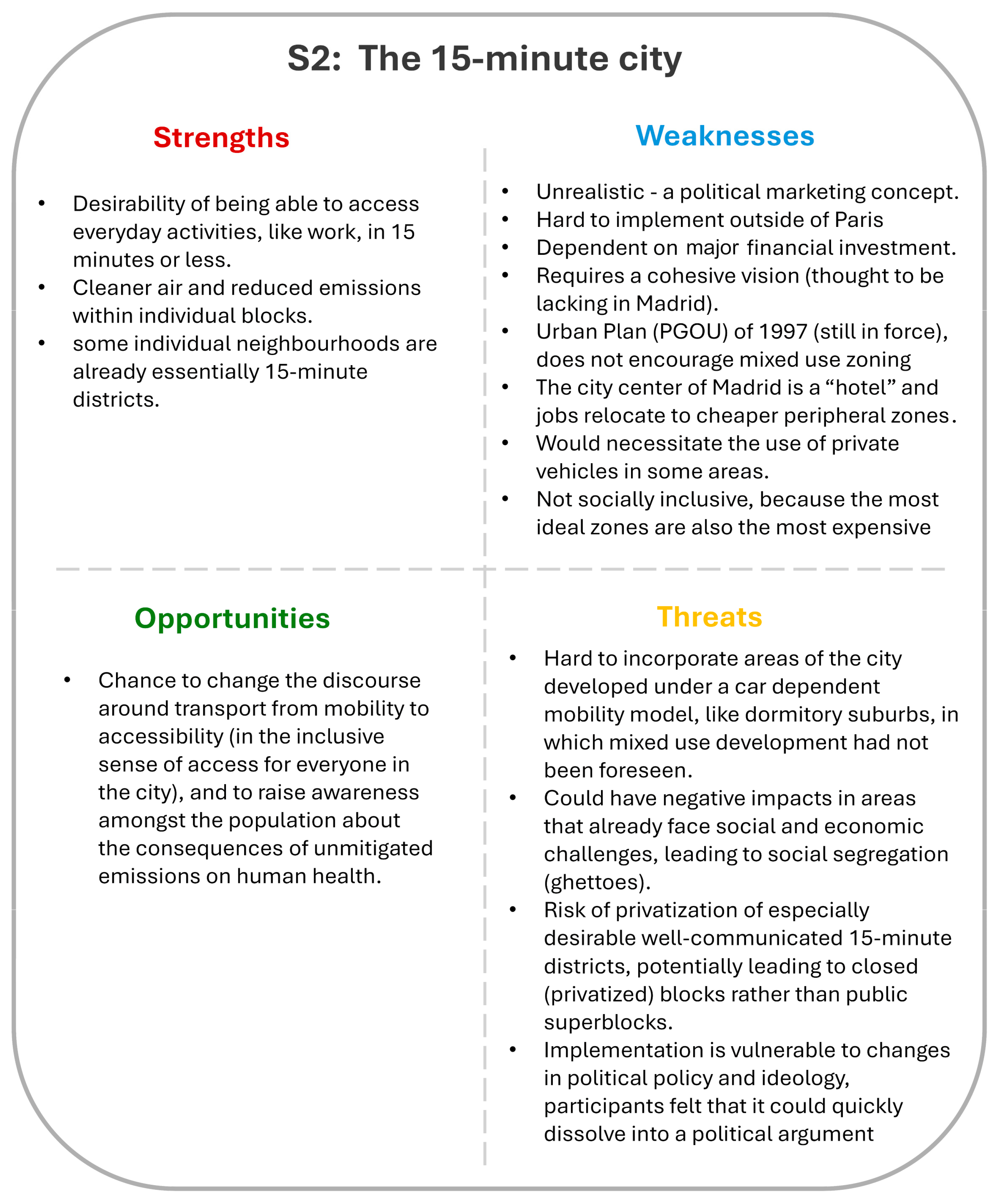
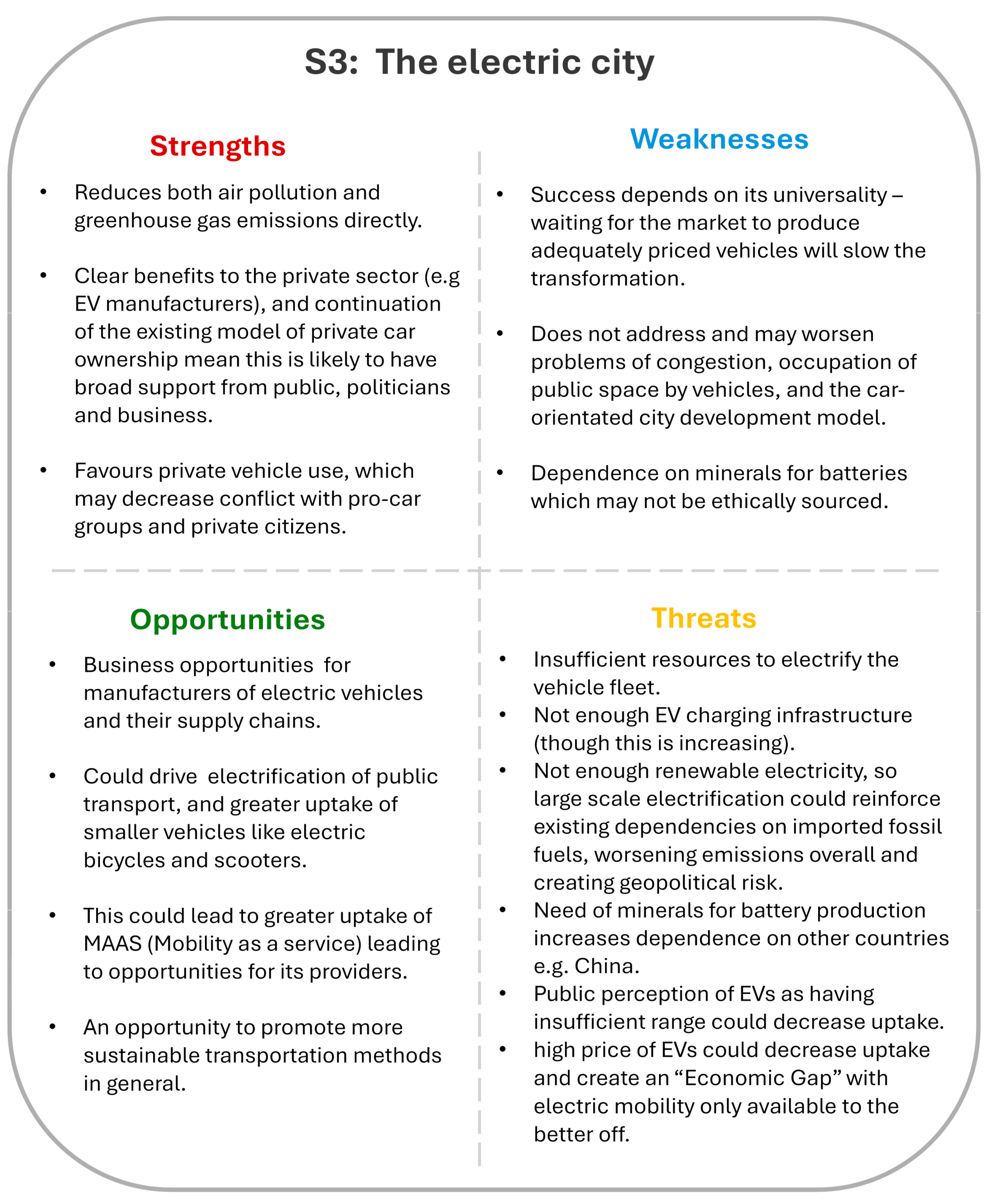
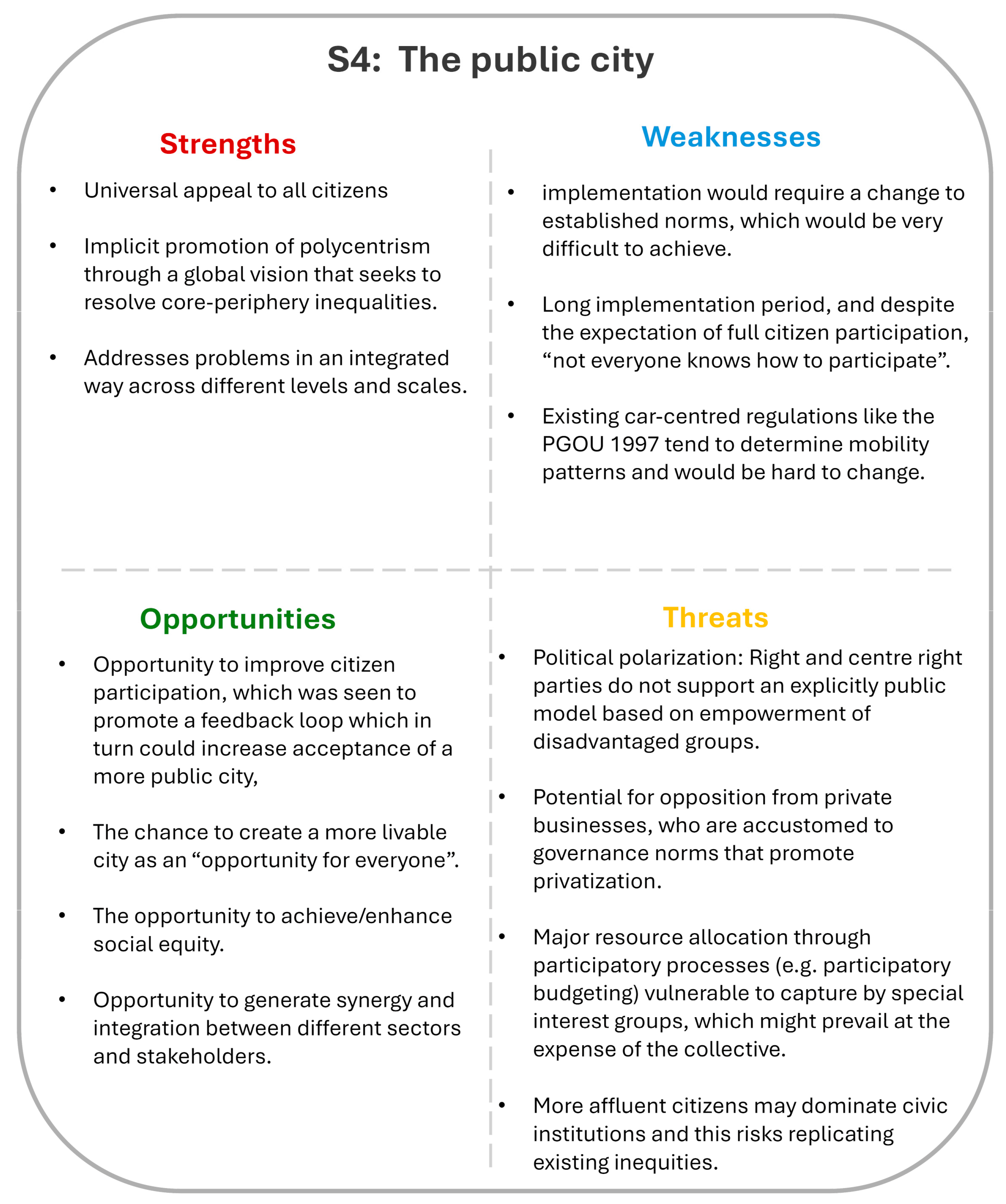
| Institution | Code | Group/Sector |
|---|---|---|
| Municipal Transport Company of Madrid | Participant 1 | Public administration (city) managing director of the municipal transport company. |
| Cambiamo Cooperative | Participant 2 | Not for profit. Bicycle mobility advocacy group |
| Regional Transport Consortium of Madrid | Participant 3 | Public administration (region). Autonomous body coordinating public transport operations across multiple providers in the Community of Madrid. |
| Vallecas Neighborhood Local Forum | Participant 4 | Neighborhood association for a central district |
| Regional Federation of Neighborhood Associations of Madrid | Participant 5 | Neighborhood association collective |
| “A Pie” (On Foot) Association | Participant 6 | Not-for-profit pedestrian advocacy |
| Sub-Department of Energy and Climate Change, Madrid City Council | Participant 7 | Public administration (city). Responsible for city energy and climate change strategy |
| Associated European Motorists | Participant 8 | Not-for-profit association of motor vehicle users |
| Tomillo Foundation | Participant 9 | Not-for-profit organization specialized in social justice |
| Transport, Infrastructure and Territory Research Group (t-GIS) of the Complutense University of Madrid (UCM) | Participants 10–16 | Academics specialized in transport geography |
| Department of Industrial Chemical Engineering and the Environment of the Polytechnic University of Madrid (UPM) | Participants 17–18 | Academics specialized in air pollution |
| Scenario | Implementation Barrier | Policy Pathway |
|---|---|---|
| Remote Working | Lack of preparedness of society | Consultation with employers and worker’s representatives would be a prerequisite for systematic implementation. |
| 15-Minute City | Associated with the political left | Focus on specific initiatives likely to receive cross-party support and raise public awareness 1 through non-partisan information campaigns |
| City plan (PGOU 1997) does not permit multi-use zoning | Include multi-use zoning in new city plan | |
| Electric City | Success depends on widespread adoption of EVs | Subsidize EV purchases, incentivize manufacturing (tax breaks) 2, use public procurement to ensure transition of public vehicle fleets |
| Public City | Opposition from business sector and right-wing parties | Raise public awareness 1 about incremental privatization of public spaces, use new city plan to limit private development encroachment on public land |
Disclaimer/Publisher’s Note: The statements, opinions and data contained in all publications are solely those of the individual author(s) and contributor(s) and not of MDPI and/or the editor(s). MDPI and/or the editor(s) disclaim responsibility for any injury to people or property resulting from any ideas, methods, instructions or products referred to in the content. |
© 2025 by the authors. Licensee MDPI, Basel, Switzerland. This article is an open access article distributed under the terms and conditions of the Creative Commons Attribution (CC BY) license (https://creativecommons.org/licenses/by/4.0/).
Share and Cite
Hewitt, R.J.; Astier, C.; Balea-Aneiros, J.; Caramés, E.; Aranda-Andrades, C.A.; Campaña-Huertas, Z.Z.; Smith, A.T. Participatory Scenario Development for Sustainable Cities: Literature Review and Case Study of Madrid, Spain. Sustainability 2025, 17, 9830. https://doi.org/10.3390/su17219830
Hewitt RJ, Astier C, Balea-Aneiros J, Caramés E, Aranda-Andrades CA, Campaña-Huertas ZZ, Smith AT. Participatory Scenario Development for Sustainable Cities: Literature Review and Case Study of Madrid, Spain. Sustainability. 2025; 17(21):9830. https://doi.org/10.3390/su17219830
Chicago/Turabian StyleHewitt, Richard J., Charlotte Astier, Juan Balea-Aneiros, Eduardo Caramés, Claudia Alejandra Aranda-Andrades, Zuleyka Zoraya Campaña-Huertas, and Alison Tara Smith. 2025. "Participatory Scenario Development for Sustainable Cities: Literature Review and Case Study of Madrid, Spain" Sustainability 17, no. 21: 9830. https://doi.org/10.3390/su17219830
APA StyleHewitt, R. J., Astier, C., Balea-Aneiros, J., Caramés, E., Aranda-Andrades, C. A., Campaña-Huertas, Z. Z., & Smith, A. T. (2025). Participatory Scenario Development for Sustainable Cities: Literature Review and Case Study of Madrid, Spain. Sustainability, 17(21), 9830. https://doi.org/10.3390/su17219830






